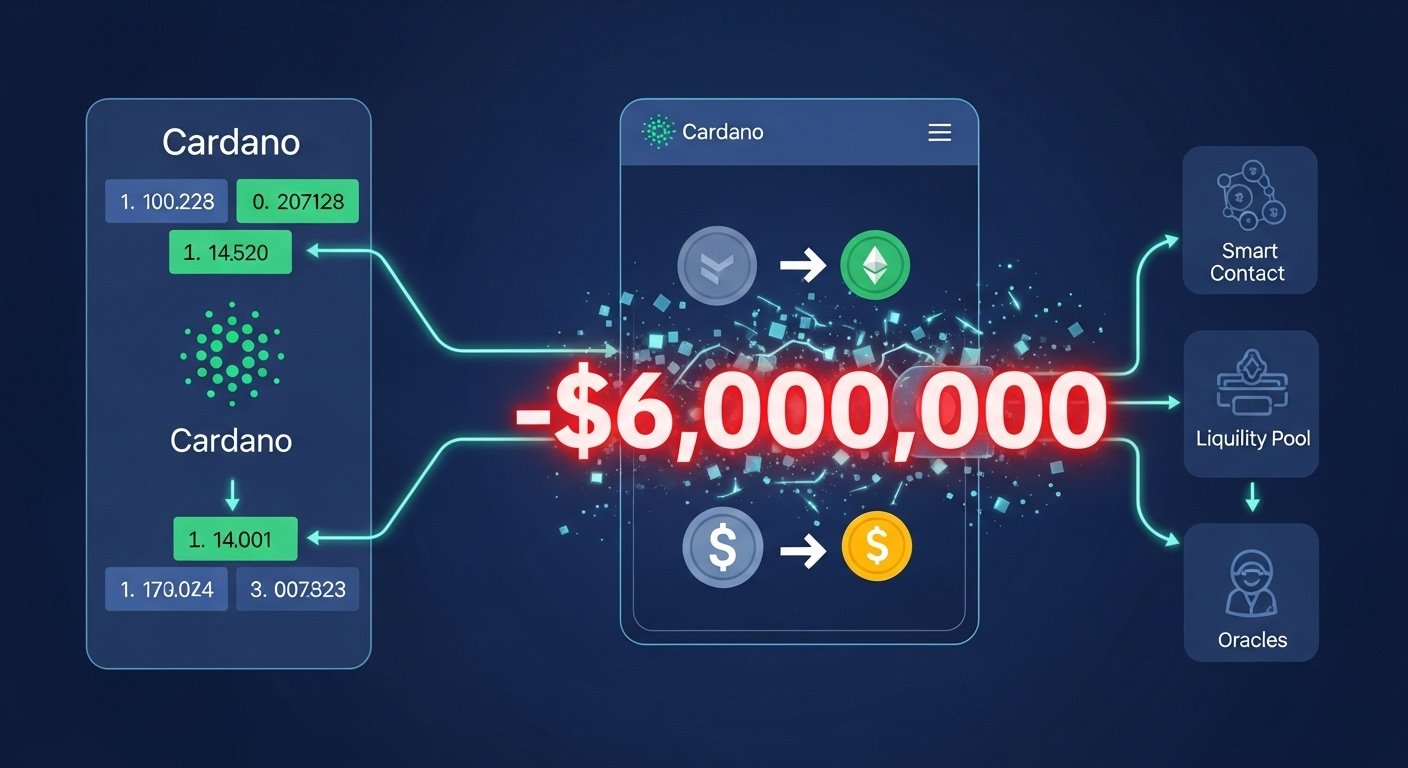Cardano Wallet Loses $6M in Stablecoin Swap Mistake
Cardano Wallet Loses $6M in a devastating stablecoin swap error. Learn how this costly crypto mistake happened and how to protect your assets.

The cryptocurrency landscape has once again demonstrated its unforgiving nature as a Cardano wallet holder experienced a catastrophic loss of approximately $6 million following what appears to be a critical error during a stablecoin exchange transaction. This incident serves as a sobering reminder of the inherent risks associated with cryptocurrency transactions and the importance of exercising extreme caution when handling digital assets, particularly when dealing with substantial amounts of value.
The incident, which has sent shockwaves through the Cardano community and broader cryptocurrency ecosystem, highlights the delicate balance between the revolutionary freedom that decentralised finance offers and the heavy burden of personal responsibility that comes with it. Unlike traditional banking systems, where certain safeguards and reversibility mechanisms exist, blockchain transactions are typically immutable once confirmed, leaving little room for error correction when mistakes occur.
This devastating loss has reignited conversations about user experience in decentralised applications, the need for enhanced security protocols, and the critical importance of implementing multiple verification steps before executing high-value transactions. Cardano Wallet Loses $6M: As we delve deeper into this unfortunate event, we’ll explore the circumstances surrounding this loss, examine how such errors can occur, and provide essential guidance for cryptocurrency holders looking to protect their digital wealth from similar misfortunes.
The Magnitude of the Loss
The $6 million loss represents one of the more significant individual transaction errors in recent cryptocurrency history, particularly within the Cardano ecosystem. To put this figure into perspective, this amount could represent years of accumulated wealth, institutional holdings, or the entire treasury of a decentralised autonomous organisation operating on the Cardano blockchain.
What makes this incident particularly tragic is that the loss appears to have resulted from human error rather than a malicious hack or sophisticated exploit. The wallet owner was reportedly attempting to perform what should have been a routine stablecoin swap—a transaction type that millions of cryptocurrency users execute daily across various blockchain networks. However, something went catastrophically wrong during the process, resulting in the irreversible loss of funds.
The Cardano blockchain, known for its research-driven approach and emphasis on security, provides users with powerful tools for managing digital assets. However, even the most secure blockchain infrastructure cannot protect users from mistakes made during transaction execution. This incident underscores the reality that while blockchain technology offers unprecedented control over one’s financial assets, this control comes with equally unprecedented responsibility.
How Stablecoin Swaps Work Cardano Wallet Loses $6M
To fully comprehend how such a devastating error could occur, it’s essential to understand the mechanics of stablecoin transactions on the Cardano network. Stablecoins are cryptocurrency tokens designed to maintain a stable value, typically pegged to traditional currencies like the US dollar. They serve as a crucial bridge between volatile cryptocurrencies and fiat currencies, offering traders and investors a way to preserve value during market turbulence.
On Cardano, stablecoin swaps typically occur through decentralised exchanges (DEXs) that leverage smart contracts to facilitate peer-to-peer trading without intermediaries. Users connect their wallets to these platforms, specify the tokens they wish to exchange, review the transaction details, and confirm the swap. The process sounds straightforward, but the devil lies in the details.
When executing a swap, users must carefully verify several critical elements: the correct token addresses, the amount being exchanged, the expected output amount after accounting for slippage and fees, and the recipient address for the swapped tokens. A mistake in any of these parameters can lead to partial or complete loss of funds. In decentralised environments, there’s typically no customer support hotline to call, no supervisor to authorise a reversal, and no safety net to catch falling funds.
The Anatomy of a Costly Mistake
While the exact details of this particular incident continue to emerge, several scenarios could explain how a $6 million loss might occur during a cryptocurrency swap. One common error involves accidentally sending tokens to the wrong address—perhaps copying an address from a previous transaction or falling victim to clipboard malware that substitutes addresses without the user’s knowledge.
Another possibility involves incorrect configuration of swap parameters, particularly when dealing with liquidity pools that might have limited depth. Setting excessive slippage tolerance, for instance, could result in receiving far fewer tokens than anticipated, effectively hemorrhaging value in the transaction. Some decentralized exchanges also present complex user interfaces that can confuse even experienced cryptocurrency traders, leading to unintended actions.
Smart contract interactions present their own unique risks. When approving token spending limits, users might inadvertently grant unlimited access to their wallet contents, potentially exposing their entire holdings to exploitation. While this scenario typically requires a malicious actor to take advantage of the excessive approval, it remains a significant vulnerability that has cost cryptocurrency users millions of dollars across various blockchain networks.
The irreversible nature of blockchain transactions means that once a mistake is made and confirmed on the network, recovery becomes virtually impossible. Unlike credit card transactions that can be disputed or wire transfers that might be recalled with sufficient speed and cooperation from financial institutions, blockchain confirmations represent permanent alterations to a distributed ledger maintained by thousands of nodes worldwide.
The Broader Implications for Crypto Security
This incident extends far beyond the personal tragedy of one wallet holder’s $6 million loss. It raises fundamental questions about the current state of user experience in decentralised finance and whether the cryptocurrency industry has adequately addressed the usability challenges that prevent mainstream adoption.
Traditional financial systems, while imperfect, have developed numerous safeguards over decades of evolution. Banks implement daily withdrawal limits, require additional verification for large transactions, provide fraud monitoring services, and offer some degree of protection against unauthorised transactions. The cryptocurrency world, in its pursuit of decentralisation and trustlessness, has largely eschewed these protections in favour of user autonomy and control.
This philosophical approach creates a double-edged sword. On one hand, cryptocurrency users enjoy unprecedented freedom from institutional oversight, censorship resistance, and the ability to move value globally without permission. On the other hand, they bear sole responsibility for securing their assets and ensuring transaction accuracy. For some users, this represents an acceptable trade-off; for others, especially those new to cryptocurrency, it creates a minefield of potential catastrophic errors.
The Cardano developer community and other blockchain ecosystems must grapple with these realities as they build the next generation of financial infrastructure. How can platforms preserve the core principles of decentralisation while implementing sensible guardrails that prevent obvious mistakes? This question lacks easy answers but demands serious consideration as cryptocurrency aims for broader adoption.
Lessons for Cryptocurrency Holders
The $6 million loss provides several crucial lessons for anyone holding or transacting in digital currencies. First and foremost, the importance of thorough verification before confirming any transaction cannot be overstated. Regardless of how routine a transaction might seem, taking an extra moment to verify addresses, amounts, and other parameters can prevent life-altering mistakes.
Implementing a personal security protocol for large transactions represents another essential practice. This might include performing test transactions with small amounts before executing larger transfers, using hardware wallets for significant holdings, maintaining separate wallets for different purposes, and never rushing through transaction confirmations regardless of time pressure or urgency.
Education plays an equally vital role in preventing such losses. Understanding how different aspects of blockchain technology work—from token standards to smart contract interactions to the mechanics of decentralised exchanges—empowers users to make informed decisions and recognise potential risks. The cryptocurrency community must prioritise accessible education that demystifies complex technical concepts for users of all experience levels.
Many experienced cryptocurrency holders also advocate for the “cold storage” approach for long-term holdings. By keeping the majority of assets in hardware wallets or other offline storage solutions, users minimise their exposure to online risks and reduce the likelihood of making costly mistakes during transactions. Only funds needed for immediate trading or use should remain in hot wallets connected to decentralised applications.
The Role of Wallet Interfaces and User Experience
The design of cryptocurrency wallets and decentralised exchange interfaces bears significant responsibility for user safety. While developers rightfully prioritise security and functionality, the user experience component sometimes receives insufficient attention, particularly regarding error prevention and clear communication of transaction consequences.
Advanced wallet interfaces now incorporate various safety features designed to prevent common mistakes. These include address book functionality to reduce manual address entry errors, clear warnings for unusual transaction patterns, confirmation screens that present transaction details in plain language, and even mandatory waiting periods for large or irreversible transactions.
Some platforms have begun implementing transaction simulation features that show users exactly what will happen when they confirm a transaction before it executes on the blockchain. This preview capability allows users to catch errors before they become permanent, providing a crucial safety net in the often-confusing world of DeFi protocols and smart contract interactions.
However, the challenge lies in balancing security features with the decentralised ethos that underpins cryptocurrency. Too many safeguards and confirmation steps can frustrate users and potentially create new vulnerabilities. Too few protections can lead to incidents like this $6 million loss. Finding the optimal middle ground requires ongoing iteration, user feedback, and willingness to prioritise user protection even when it slightly compromises transaction speed or convenience.
Recovery Possibilities and Blockchain Limitations
When a transaction error occurs on a blockchain network, affected users naturally wonder about recovery possibilities. Unfortunately, the immutable nature of blockchain technology severely limits options for recovering lost funds. Once a transaction receives sufficient confirmations, it becomes part of the permanent blockchain history, distributed across thousands of nodes worldwide.
In some rare circumstances, funds sent to incorrect addresses might be recoverable if the address owner can be identified and proves willing to return the assets. However, in many cases, funds are sent to addresses for which no private keys exist—effectively burning the tokens and removing them from circulation permanently. Other scenarios involve sending funds to smart contract addresses that lack withdrawal functions, permanently locking the assets within the contract.
The Cardano blockchain, like most major cryptocurrency networks, has no built-in mechanism for reversing transactions or implementing chain rollbacks except under the most extraordinary circumstances that threaten the network’s integrity itself. Individual user errors, regardless of the amount involved, don’t meet this threshold and won’t trigger network-level interventions.
Some blockchain communities have debated implementing optional transaction reversibility features or creating decentralised arbitration systems to handle disputes and errors. However, these proposals often face significant philosophical opposition from cryptocurrency purists who view immutability as a foundational principle that shouldn’t be compromised under any circumstances. This tension between pragmatic user protection and ideological purity continues to shape cryptocurrency development.
Preventing Future Losses in the Cardano Ecosystem
The Cardano community can take several proactive steps to minimise the likelihood of similar incidents occurring in the future. Enhanced wallet notifications that clearly communicate transaction details in plain language can help users catch errors before confirmation. Standardised warning systems for unusual transactions—such as those involving unfamiliar addresses or amounts significantly larger than a user’s transaction history—could provide additional safety layers.
Developer education represents another crucial component. Teams building decentralized applications on Cardano should prioritise user experience and error prevention in their design processes. This includes conducting extensive user testing with individuals of varying cryptocurrency experience levels, implementing clear visual hierarchies that draw attention to critical information, and providing comprehensive documentation that explains potential risks in an accessible language.
The broader cryptocurrency industry might also benefit from developing standardised best practices for high-value transactions. Just as traditional financial institutions follow protocols for wire transfers and large cash transactions, the cryptocurrency ecosystem could establish community-driven guidelines that users voluntarily adopt to protect themselves from costly mistakes.
Insurance products specifically designed for cryptocurrency holders represent an emerging market that could provide some protection against certain types of losses. While insurance cannot prevent errors from occurring, it can mitigate their financial impact and provide users with greater peace of mind when transacting significant amounts. However, such products would need careful structuring to prevent moral hazard and ensure they remain economically viable for insurers.
Conclusion
The loss of $6 million from a Cardano wallet during a mistaken stablecoin swap serves as a stark reminder of the responsibilities that accompany cryptocurrency ownership. While blockchain technology offers revolutionary potential for financial freedom and decentralisation, it demands a corresponding level of caution, knowledge, and careful execution from its users. This incident should motivate both individual cryptocurrency holders and the broader development community to prioritise safety, education, and user experience improvements that can prevent similar tragedies in the future.
As the cryptocurrency industry matures and seeks wider adoption, addressing the balance between user autonomy and protective measures will remain critical. The freedom that blockchain technology provides must be matched with accessible tools and clear guidance that help users navigate this complex landscape safely. For those holding digital assets on Cardano or any other blockchain network, this incident underscores the paramount importance of verification, education, and implementing personal security protocols that minimise the risk of catastrophic errors.
The future of cryptocurrency depends not only on technological innovation but also on creating an ecosystem where users can confidently manage their assets without living in constant fear of irreversible mistakes. Only by learning from incidents like this and continuously improving our systems, interfaces, and practices can the cryptocurrency community build a truly accessible and sustainable financial future for everyone.
FAQs
Q: Can lost cryptocurrency ever be recovered after a transaction error?
Recovery of lost cryptocurrency depends entirely on where the funds were sent. If they went to an address controlled by someone who can be contacted and is willing to return them, recovery is possible. However, if funds were sent to an incorrect address with no known owner.
Q: What security measures should I implement before making large cryptocurrency transactions?
Before executing large cryptocurrency transactions, always perform a test transaction with a small amount first, double-check all addresses and amounts, use hardware wallets for significant holdings, and enable all available security features on your wallet.
Q: Are stablecoin swaps on Cardano generally safe?
Stablecoin swaps on Cardano are generally safe when executed correctly through reputable decentralised exchanges and with proper verification of transaction details. The Cardano blockchain itself is highly secure and has undergone extensive peer review. However, user error remains the primary risk factor.
Q: What makes cryptocurrency transactions irreversible compared to traditional banking?
Cryptocurrency transactions are irreversible because they’re recorded on distributed ledgers maintained by thousands of independent nodes worldwide. Once a transaction receives sufficient confirmations, it becomes part of the permanent blockchain history.
Q: How can the cryptocurrency industry improve user experience to prevent such losses?
The cryptocurrency industry can improve user experience by implementing transaction simulation previews, creating standardised warning systems for unusual transactions, and developing more intuitive wallet interfaces with clear visual hierarchies.


